Enteral and Parenteral Nutrition Support
What is Nutrition Support Therapy?
Nutrition support is “food” provided either by a tube or IV when a person is not able to eat enough, or at all, by mouth. When nutrition support is provided through a tube into the stomach or small intestine it is called enteral nutrition (EN). EN is the first choice for nutrition support when a person is unable to eat by mouth. However if the GI tract is non-functional due to medical reasons, sometimes nutrition support is provided via parenteral nutrition (PN), which is given through the veins. Enteral and parenteral nutrition may be given for as little as a few days to weeks or life-long. The goal of nutrition support is provide adequate nutrition for growth, development, and healing. Each patient’s nutrition support prescription is tailored to their individual needs.
Enteral Nutrition
Enteral nutrition, or tube feeding, may be indicated when a person has inadequate oral intake or increased nutrition needs. Inadequate oral intake may be related to dysphagia, feeding difficulties, decreased appetite, GI intolerances, or eating disorders. A person may have increased nutrition needs related to acute illness, chronic disease, or surgery. Tube feeding formulas can provide complete nutrition including carbohydrates, protein, fat, vitamins, minerals, and water. Infants and children, as well as adults may receive tube feedings. If a person is able to eat some by mouth but not meet 100% of nutrition needs, an oral diet may be continued along with tube feeding.
There are a few types of enteral feeding tubes. Minimally invasive feeding tubes intended for short term use (up to 4-6 weeks) are inserted though the nostril and placed in the stomach (nasogastric tube or NG) or small bowel (nasojejunal tube or NJ). If tube feeding is needed for a longer-term period, a surgically placed tube may be indicated. A PEG or G-tube is placed in the stomach and a J-tube is placed in the jejunum portion of the small bowel.
Gastric vs Small Bowel Feeding
Gastric feedings are typically well tolerated by patients who cannot meet their nutrition needs orally but otherwise have a normally functioning GI tract. Gastric feedings can be given by bolus, gravity, or continuous infusion. Small bowel feedings are given when a person is unable to tolerate gastric feeding; usually due to gastroparesis, nausea and vomiting, or ileus. Small bowel feedings must be given by continuous or intermittent infusion.
Enteral Nutrition Formulas
There are different types of formulas to meet the many needs of people fed through feeding tubes. Specialty formulas exist for diabetes, renal disease and fluid restriction. There are also formulas available with extensively hydrolyzed proteins and medium chain triglycerides to improve tolerance for people with GI conditions, food allergies or people recovering from severe illness. Increasing in popularity are blenderized tube feeding formulas which allow patients to “eat” more whole food ingredients. Schedule an appointment with our Registered Dietitian and Certified Nutrition Support Clinician to customize an enteral feeding prescription tailored to your needs.
Parenteral Nutrition
Whenever possible, it is ideal to use enteral nutrition for nutrition support because parenteral nutrition requires IV access which increases infection risk. It is also best to stimulate the GI tract to maintain good gut flora. However, if a patient is unable to tolerate enteral nutrition, parenteral nutrition is used to meet nutrition and hydration needs. Total parenteral nutrition (TPN) provides all of a patients nutrition needs and is given through a central IV line. TPN is intended for patients who require prolonged bowel rest or have non-functioning GI tract. This may be caused by a fistula, obstruction, or extensive bowel resection resulting in malabsorption. Peripheral parenteral nutrition (PPN) is given though a peripheral IV line which reduces the risk for infection. However, this usually can only provide a portion of a patients nutrition needs due to the limited osmolarity tolerated through the peripheral line. PPN may be used if a patient is expected to only need parenteral nutrition for a few days or if they are able to tolerate small amounts of enteral nutrition. TPN and PPN formulas are highly specialized to meet the patients’ specific macro-nutrient and micro-nutrient needs. They hang in a bag like IV fluids and usually have a yellow color.
Transitioning from Nutrition Support
Nutrition support is not always long term. Sometimes patients transition from parenteral nutrition to enteral nutrition or oral nutrition and from enteral nutrition to oral nutrition. Regardless of the nutrition route, the goal is to make sure you are meeting your calorie, protein, hydration and nutrient needs at all times.
 Make an appointment with Madden Wilson our Registered Dietitian and Certified Nutrition Support Clinician to manage your nutrition support and ensure you are meeting all of your nutrition needs.
Make an appointment with Madden Wilson our Registered Dietitian and Certified Nutrition Support Clinician to manage your nutrition support and ensure you are meeting all of your nutrition needs.
Visit the American Society for Pareneteral and Enteral Nutrition (A.S.P.E.N.) at
www.nutritioncare.org for additional information regarding nutrition support














